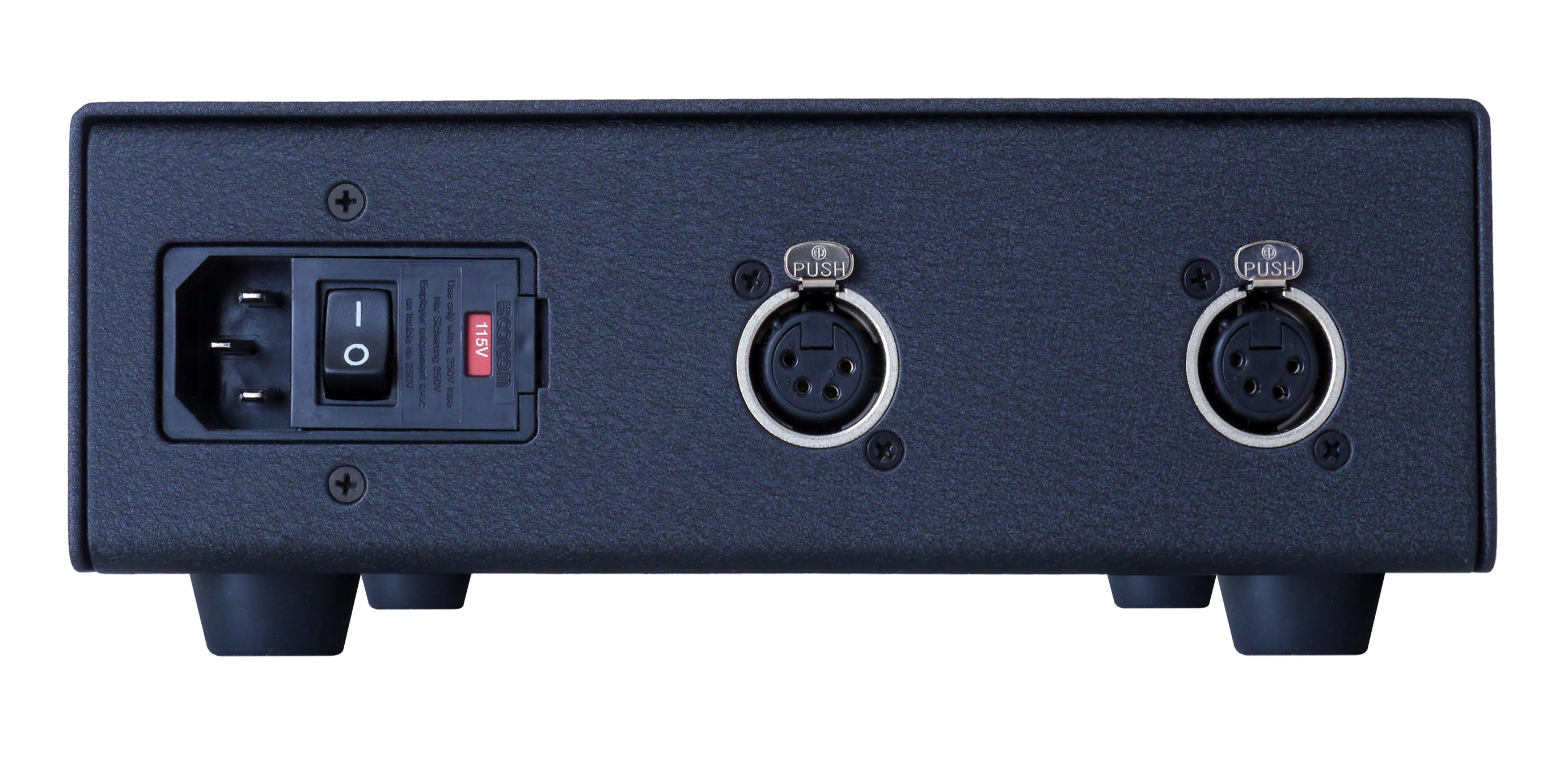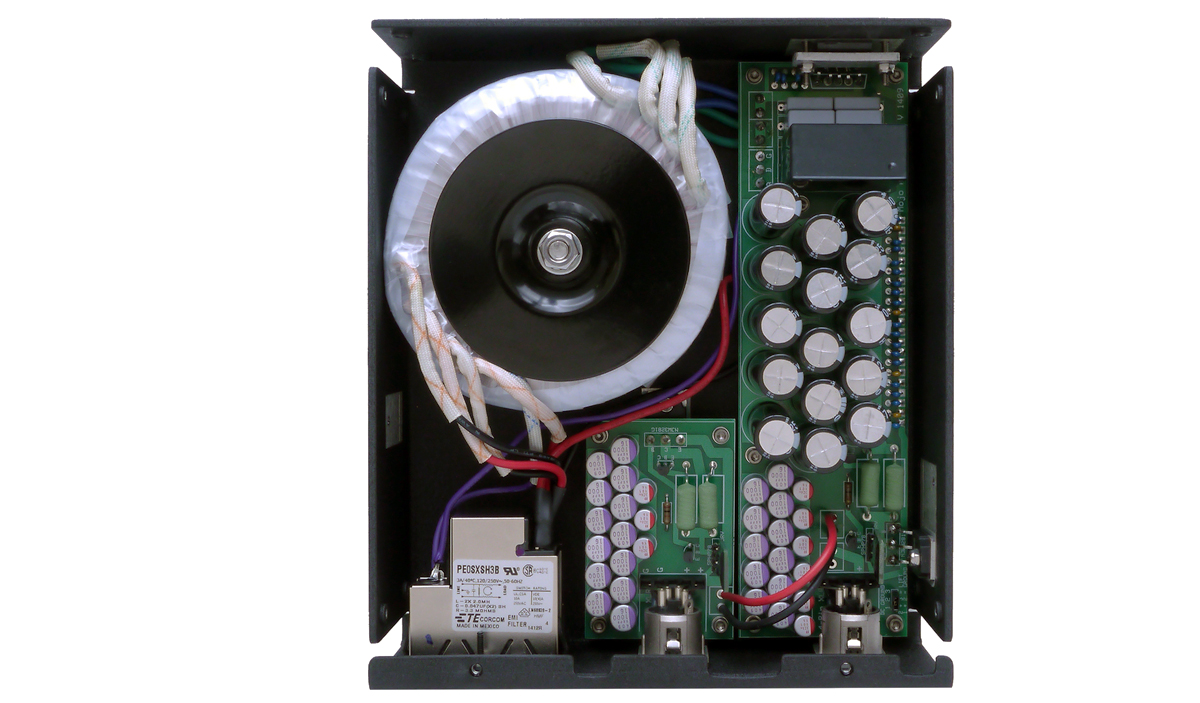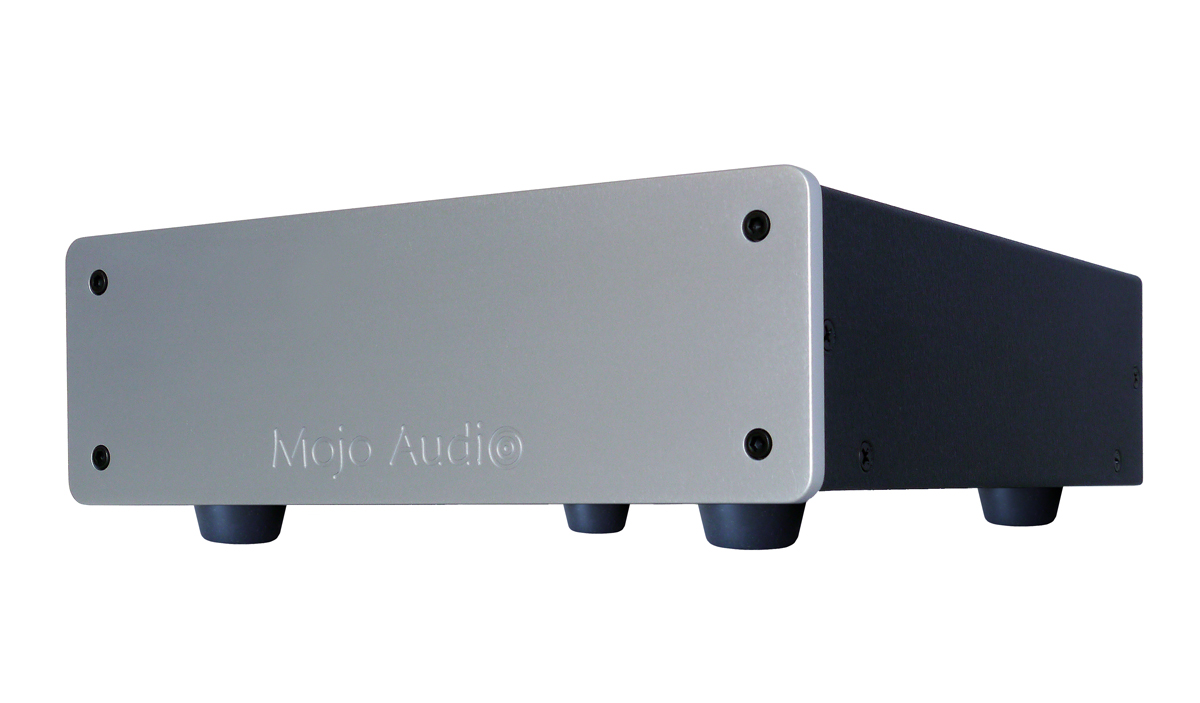High End Audio, to me, means finding good sound, then searching for better. When you start out, “bang for the buck” is what you look for, and you’re SURE you’ll never be one of those crazies who spends a fortune trying to hear the sound of the subway under Carnegie Hall on your Shaded Dog. In time, you start listening for that rumbling. This brings me to our subject, power supplies, specifically the Mojo Audio Joule v6 Linear Power Supply (LPS). I was quite satisfied with my Linear Tube Audio (LTA) MicroZOTL2 as my main headphone amp, which comes with an external switching power supply. There were rumbles on Headfi.org that it scales up with an LPS (the Mojo specifically). Then LTA came out with its own lower priced LPS. I immediately purchased it. Subsequently Ben Zweikel at Mojo offered me a sample of the Joule v5 for review. I didn’t know what I was letting myself in for. Here’s what Ben had to say about his LPS…
“The biggest differences between our Joule v5 and most linear power supplies on the market has to do with how much lower noise and how much faster dynamic response our proprietary discrete regulator has over the run-of-the-mill IC chip regulators, such as the LT1083, that most of our competitors are using. Of course these companies market to the average audiophile, whereas Mojo Audio markets to the ultra-purist. Keep in mind that it would be a waste of money for a person with a modest resolution source and modest resolution transducers to upgrade their power supplies to our level of performance.
For reference, the proprietary regulators engineered for Mojo Audio by Belleson have roughly 1/50th the noise of of the common LT1083 IC regulator most audiophile companies are using. And the dynamic response of our power supplies is so fast it is almost immeasurable without specialized equipment: 10nS from zero to full current output. Comparing the performance of our power supplies to most on the market would be like comparing a Toyota to a Ferrari. Of course you could only fully appreciate the difference between those two cars on a flawlessly smooth race track and not on city streets. On city streets it would make more sense to have the lower performance Toyota. Similarly, it would make more sense to have a more modest performing power supply if your source has a modest level of performance. All an ultra-low noise power supply will do in a more modest resolution system is show you every flaw in your source, much like a Ferrari will let you feel every pebble in the road.”

I started evaluating on my digital/PC system (PC, LH Labs 2G split USB cable, Regen (not sure what to label the Regen as), LH Labs Geek Out Special Edition DAC, Audioquest cable, MicroZOTL2 amplifier, Hifiman HE-1000 headphones/Norne Zoetic Cable). I Scrolled JRiver to Chuck Prophet’s “Lonely Desolation” (Night Surfer 16/44 FLAC CD rip). I noted improvements going from switching supply to LTA LPS to Mojo Joule. There was more noise/ haze on the stock supply, with flattening of the soundstage. This opened more with the LTA LPS, and things were even more open with the Mojo. Pizzicato strings in the background had more pluck and bounce, the guitar had more bite, and backgrounds were darker. The musicians “clicked” more, were more “in the groove”. I played some jazz-“Ebb And Flow”, by the great bassist Dave Holland (Pathways, 16/44 flac CD rip), and on the switching supply there was some mild hash and confusion, which was improved with the LTA supply, but going to the Mojo the front line horns were more easily separated, the stage was wider, deeper, blacker, the cymbal more palpable, bass more textured. Maria Lambert’s “Girls” (from the rocking country “Platinum”, 16/44 FLAC cd rip), using the stock supply, sounded splashy, cymbals more diffuse, depth less deep and background had a mild ground glass haziness. The Mojo takes transforms the presentation, with more natural guitar tone, the acoustic guitar in the background more present and clear, that slight glaze is diminished, harmonies are in perfect sync, with a background disembodied vocalist at the end, whose words I could only understand through the Mojo powered system. Now, as I often say, the act of describing differences tends to magnify them. The sound was fine in all the configurations, but the ease and naturalness of the Joule, while these small improvements led to more coherence, a more realistic presentation. These small and not so small objective improvements can result in dramatic musical revelations.
My best rig is analog (which is back-it never left Chez Skowron), consisting of a fully loaded Linn LP12 turntable with an Ittok arm and Lyra Delos cartridge, a Pro-Ject Phono Box S phono preamp, into the MicroZOTL2. The Linn sits on a Machine Dynamics Nimbus isolation stand (great for my suspended wood floor, the needle wouldn’t jump in an earthquake!). When I started listening to my HE-1000 headphones through this set up, I couldn’t stop…I was bleary eyed for days! First off the record racks was the Mosaic Box “The Complete Candid Recordings of Cecil Taylor and Buell Neidlinger (Mosaic MR-6-127); dropped the needle on Duke Ellington’s “Jumpin’ Pumpkins”, and once again, both LPS units improved on the switching supply, with things tightening up and sounding great on the LTA, but the Mojo did give horns richer tone, the trombone more friskiness, the soundstage more depth and blackness and less fine grain. Taylor is wild (though he would get wilder in later years),and the mix of tightness and abandon of the band, playing in sync, is palpable.
Ry Cooder is an old favorite. “Mexican Divorce” from Paradise and Lunch (Warner Brothers 0598) sounds fine with the stock supply, though by now I recognize the grain and soundstage limitations (the old blues lyric, “you don’t miss your water ’till your well runs dry” is reverse, you don’t notice the grain until you upgrade your gear). LTA gets more snap, tighter bass. There’s strong string and percussion transients captured, the pluck and release of guitar strings, the mallet striking the marimba. . Going to the Mojo, some haziness I didn’t recognize with the LTA is gone, there is more coherence, with the band grooving in lockstep, reacting to each other. Inter-instrument space is more, well, “spacey”, timbers more believable, and the transient snaps could cut a limb off! Man, the chorus behind Cooder is lined up, I can see them in my mind’s eye. Eerie… I pulled out a shaded dog of Heifetz/Munch playing Beethoven’s Concerto in D, Op61 (RCA LSC-1992) (to add a little class to the joint, and to show off I have Shaded Dogs, Mercs and the like), and on the stock supply, the violin sounds strident, but gains more richness on the LTA with better imaging, and the Mojo snaps together the musical counterpoints, reveals the touch and technique of Heifetz (the cadenza is a breathtaking knockout). There is a better communication of the event, with the venue, different sections, spread out beautifully.
I pulled out some new purchases, first a reissue of The Turtles singles on 45 RPM (The 45 RPM Singles Collection FloEdCo), which was likely not sourced from a master, but did highlight the changes in power supplies again, with the switching OK, but trumpet having some unnatural harshness, the LTA cleaning up the sound, adding depth, adding sweetness to the strings, and the Mojo taking it all the way home, horns still not 100% convincing, but about 80% of the way there (that’s why I think it’s not sourced from the master), but there was a rightness the Mojo brought, with Howard Kaylans vocals textured, you can sense his body in the room. There’s great depth and details, and some variations in dynamics that I didn’t notice previously despite hearing this thousands of times.
One great thing about the vinyl renaissance is NEW RECORDS!!! Not another reissue of Kind Of Blue, NEW MUSIC. So, I pulled out Allison Miller’s Boom Tic Boom (now THERE’S a band name), Otis Was a Polar Bear (Now THERE’S an album name), (Royal Potato Family LP), cued up track 1, “Fuster”, and let her rip. This band is post bop, with some Middle Eastern and reggae (!!!) influences (it would be considered a Super Group, with Myra Melford, piano; Jenny Scheinman, violin; Kirk Knuffke, trumpet; Ben Goldberg, clarinet; and Todd Sickafoose, bass; the leader on drums; if the world was a just place and Joe Q Public KNEW who these magnificent players are…). I’ll skip the stepwise progression and go to the Mojo. Mojo revealed this to be a great recording (it should be a demo disk), with open space, rich clarinet tone, cavernous bass, great piano and drums (instruments I find the hardest to render convincingly). But it’s not just the sounds, it’s the timing. There is a simultaneous relaxation and tightening of the sound…the overall presentation gains ease, while the music tightens, nuances and interactions are revealed. Details like the wood block Miller uses are so convincing through the Mojo (I had thought it was a snare rim shot). The players lock in more…this Klezmer meets funk had me bouncing, dancing, and kvelling, the opening violin-clarinet duet is heart breaking, the clarinet has more body, is more 3D, and the whole experience is total bliss.

I think, in these digital days, people understand digital concepts better, so, while not technically related, I’ll use it as an analogy. While the notes remain fixed, the subtle timing of their arrival makes a major difference in pace, rhythm, texture of notes, of a performance clicking the way it did at the session. This doesn’t change saxophones into flutes, but it goes a long way towards communicating the essence of the music. Lessening noise and preserving the tiny, delicate electronic signal enhances timing, and makes the difference between mid fi OK sound and Summit Fi sound. It is definitely a diminishing returns endeavor, but not without payoff. For, the timing and realism of a performance is a very small improvement in some ways, but it can be a gigantic improvement in your enjoyment and engagement with the music.
Should you upgrade? Do you prefer a Lexus to a Corolla? A fine French wine to Manischewitz? A Kobe steak to a White Castle Burger (there are, of course, times the Corolla, Manschewitz, and hamburger are exactly what you want, but never mind…)? You (and I) can’t always afford to go for the highest rung, and good stuff can be had at lower expense. You will be fine with the stock supply; I loved it for a year. The LTA LPS gets you very far towards that Top Of The Line sound, for a decent price, and I’ve lived quite happily with it as well. At greater than twice the cost, the Mojo takes you to the next level. Is it day and night? No, but these objectively subtle enhancements, yield major dividends in enjoyment, realism, and involvement. Cost effective? That’s a personal decision, of course, but I’ve been taught a lesson about the importance of the power supply in the chain, and will be going for the best I can manage. You should too. More Power To You!
Details from the Mojo web site:
Features and Specifications:
- Less noise than a LiO4
- Less than 50uV of peak-to-peak noise/ripple.
- Less than 10uS settling time from zero to full output.
- Up to 7 amps continuous power with up to 10 amp peaks.
- Hot parts are heat sunk to the exterior allowing heat to dissipate through the entire chassis.
- Sophisticated AC filtering, so that no special power conditioners are required.
- Cascaded spread spectrum capacitive filtering for expanded bandwidth.
- DC ground lift option allows separating AC and DC grounding.
- Easily converted from 115V to 230V AC at IEC inlet.
We use only the highest-quality parts:
- Belleson ultralow-noise high-dynamic regulators.
- Organic polymer capacitors with ESR as low as 7mOhms.
- High-frequency MLCC capacitors to filter beyond 3GHz.
- IXYS ultrafast soft recovery Hexfred diode bridge.
- Laboratory grade filtered/fused/switched AC power inlet.
- Neutrik silver-plated 10A + 10A XLR DC power outlets.
- Ultra-heavy gauge .125″ thick all-aluminum chassis.
- All non-magnetic stainless steel PEMs and hardware.
- Durable high-temp powder coating inside and out.
- Sorbothane or Stillpoints anti-resonant feet.
- Price: $999.95















Want to join discussion?
Feel free to contribute!